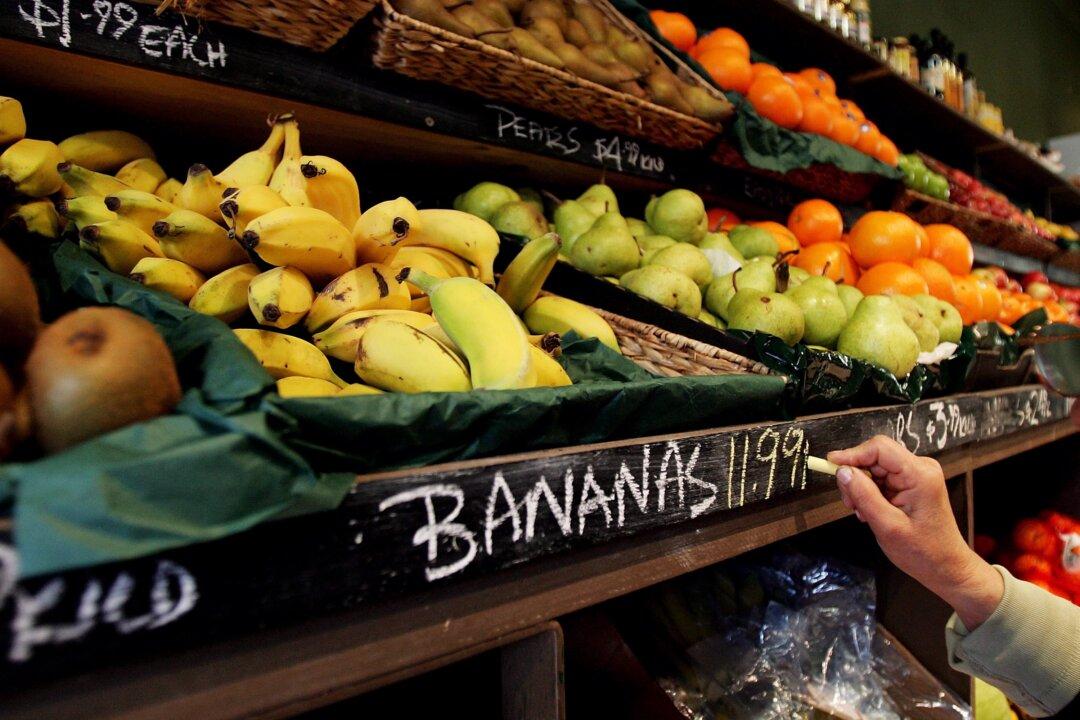Three-quarters of non-organic foods sampled by U.S. agencies had “potentially harmful pesticides,” according to an environmental group that identified 12 fruits and veggies with high pesticide contamination as well as 15 with the least.
“EWG determined that 75 percent of all conventional (non-organic) fresh produce sampled had residues of potentially harmful pesticides.”
While the USDA peels/scrubs and washes the samples prior to testing, the FDA only removes the dirt. “Even after these steps, the agencies’ tests still found traces of 254 pesticides in all fruits and vegetables tested.” Among the 46 items sampled in the analysis, 12 were classified as the “Dirty Dozen” and 15 as “Clean Fifteen.”
In the Dirty Dozen list, 95 percent of samples contained pesticides. The items on the list are strawberries, spinach, kale, collard, mustard greens, grapes, peaches, pears, nectarines, apples, bell and hot peppers, cherries, blueberries, and green beans.
Among the Dirty Dozen, 209 pesticides were found. “More than 50 pesticides were detected on samples from each item on the Dirty Dozen, except cherries … All of the produce on the Dirty Dozen had at least one sample with at least 13 pesticides—and some had as many as 23,” EWG said.
“The most pesticides were found on kale, collard, and mustard greens, with 103 individual chemicals found across the items in the category. Hot peppers and bell peppers were next, with 101.”
Out of the five most frequently found pesticides in the Dirty Dozen, four were fungicides—pesticides that control or kill the fungus causing diseases like powdery mildew. Fungicides are often applied after harvest to keep the fruit and vegetables mold-free as they make their way into the market.
“That’s likely why fungicide concentrations can be so high on some samples—higher than other pesticides applied earlier in the growing season,” EWG noted. Fungicides have been linked to health complications like boosting the proliferation of breast cancer cells, harming the male reproductive system, metabolic disorders, and liver toxicity.
The Clean Fifteen produce are avocados, sweet corn, pineapple, onions, papaya, sweet peas (frozen), asparagus, honeydew melon, kiwi, cabbage, watermelon, mushrooms, mangoes, sweet potatoes, and carrots.
Almost 65 percent of fruit and vegetable samples in this list had no detectable pesticide residue, and just over 10 percent of samples had residues of two or more pesticides.
In 2022, USDA tested baby foods for pesticides, and the results showed that non-organic baby foods were “considerably less contaminated by pesticides than their whole fruit and vegetable counterparts,” EWG stated.
Opposition of Farmers
EWG recommended in the report that consumers seeking fresh produce with low pesticide residues should consider buying “organic versions of items on EWG’s Dirty Dozen and either organic or non-organic versions of produce on the Clean Fifteen.”The report has come under criticism from farming groups. In an interview with CNN, Carl Winter, emeritus professor of cooperative extension at the University of California, Davis, pointed out that the “dose makes the poison, not its presence or its absence.”
“And that dose determines the potential for harm. In many cases you’d have to be exposed to a million times more than what we’re exposed to before you’d even see any effects,” he said while speaking on behalf of the Alliance on Food and Farming.
California-based farmer Neil Nagata said the EWG report could scare people away from eating fresh fruit and veggies. His family has been engaged in farming for several decades.
“Every time the report comes out, or there’s a scare on imported strawberries, we see our sales drop off,” he said.
“It’s not as if we’re doing something that is wrong or incorrect, we’re actually producing very healthy, safe food. In fact, we actually live in the strawberry field and my father is 100 and my mom is 97, and they still eat strawberries.”
The U.S. Centers for Disease Control and Prevention (CDC) warns that some pesticides “could increase your chances of having a miscarriage, a baby with birth defects, or other problems.” Certain pesticides “may be able to pass into breast milk” as well.
People who are likely to be more exposed to pesticides are farmers, greenhouse workers, lawn/pest service providers, veterinary workers and animal handlers, aircrew members, and landscapers.
In February 2020, the EWG published a report assessing the U.S. Environmental Protection Agency’s (EPA) role in protecting children from pesticides in food. It found that the EPA “has failed to adequately protect children from pesticides,” EWG stated.
“For almost 90 percent of the most common pesticides, the agency has neglected to apply the Food Quality Protection Act–mandated children’s health safety factor to the allowable limits,” it said.







